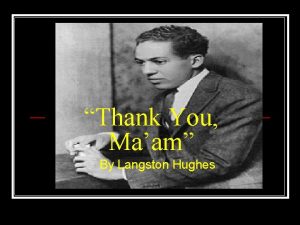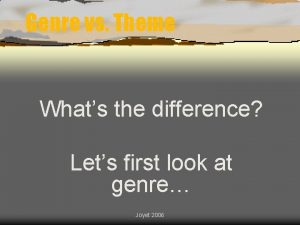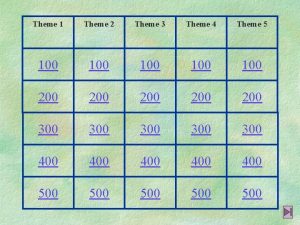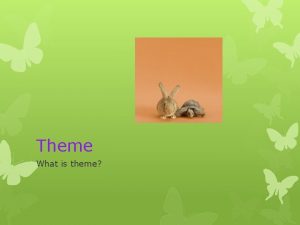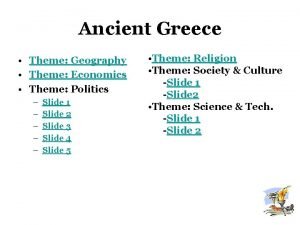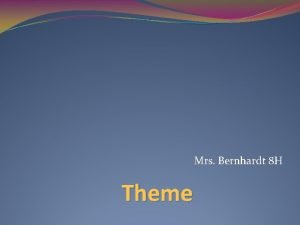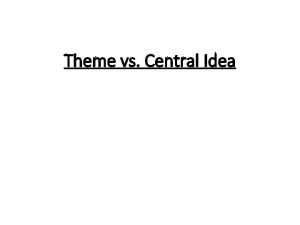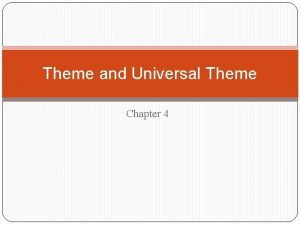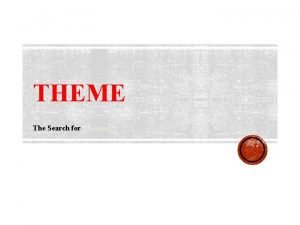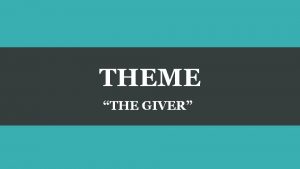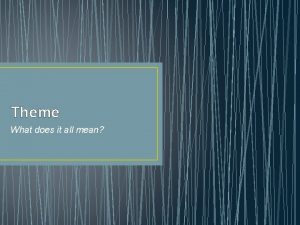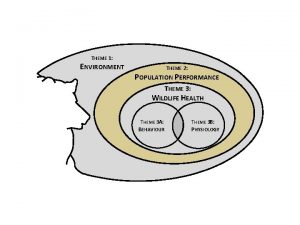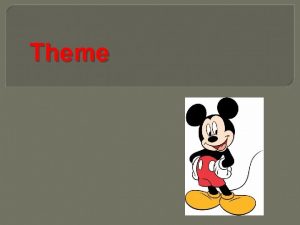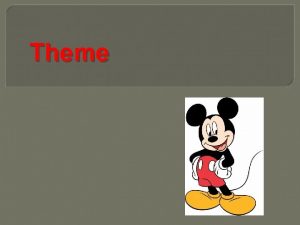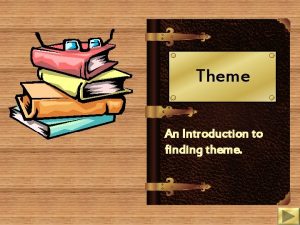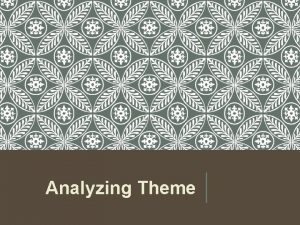HOW TO ANALYZE THE DEVELOPMENT OF THEME Thank













































- Slides: 45

HOW TO ANALYZE THE DEVELOPMENT OF THEME

Thank you for purchasing this teaching unit. We hope you love it! Tammy and Shannon By Shannon Temple and Tammy Lewis ELA Core Plans S&T Publications, LLC Copyright © 2016 S&T Publications, LLC Limited reproduction permission: For each ebook purchased, S&T Publications grants permission for only one teacher to make as many copies as needed for his or her classes. Reproduction by/for other teachers, classes, or for commercial use is strictly prohibited.

I can analyze the development of a theme. Analyze = break into parts or find some new understanding from the text Development of theme = how the life lesson is created over the course of the story

The theme of a story is the lesson about life that can be taken away after reading the story. To analyze the development of a theme, you have to think of literary elements that help to develop it. Think of theme as a nail. Theme If theme is a nail, then the characters, plot, and setting are the hammer! The hammer helps put the nail in place. Characters, plot, and setting help put a theme in a story. To analyze the development of a theme, you must look at how these elements help to create it. Characters Plot Setting It takes an entire story- the beginning, the middle, and the end to “hammer” in the nail – to develop theme.

To analyze the development of theme in a story, we have to do two things. q Look at what helps develop theme. q. Look at how theme is developed. What develops theme? • Setting • Characters • Plot How is theme developed? What did the author do to create this theme? Look at how theme… Ø Is being set up in the beginning Ø Grows more obvious in the middle Ø Is shown complete by the end

If you saw an egg lying on the ground and there were hens, ducks, and geese around, would you know what was inside of the egg? This is the same thing as theme at the beginning of the story. You do not know what theme is at the beginning, but you know there will be one. There is an “egg”. The author will use the setting, plot, and/or characters in the beginning of the story to lead to “what’s inside the egg” or theme at the end.

If one day, you saw a hen sitting on that egg, it would become more obvious that a chicken was inside of the egg, but you still would not know for sure. Perhaps the chicken was sitting on the duck’s egg. This analogy can be related to the development of theme in a story. At the beginning, the reader has no idea what theme will be. However, by the middle, theme is usually becoming more obvious. The setting, plot, and characters can help make theme more obvious in the middle of a story. Readers may start to make predictions about theme in the middle of a story.

It is only when the baby chick comes out of the egg that you realize for sure what was inside of the egg all along. This analogy can be related to the development of theme in a story. At the end, theme is finally made clear. It is only after a theme is made clear that a reader may look back to analyze how the author developed this theme. What did the author do all along to create this theme?

To learn how to analyze the development of a theme, let’s read a fable. The Fox and the Goat A Fox fell into a well and was unable to get out again. By and by a thirsty Goat came by, and seeing the Fox in the well asked him if the water was good. "Good? " said the Fox. “It's the best water I ever tasted in all my life. Come down and try it yourself. " The Goat thought of nothing but the prospect of quenching his thirst and jumped in at once. When he had enough to drink, he looked about, like the Fox, for some way of getting out but could find none. Presently the Fox said, "I have an idea. You stand on your hind legs, and plant your forelegs firmly against the side of the well, and then I'll climb on to your back, and, from there, by stepping on your horns, I can get out. And when I'm out, I'll help you out too. " The Goat did as he was requested, and the Fox climbed on to his back and so out of the well. Then, he coolly walked away. The Goat called loudly after him and reminded him of his promise to help him out, but the Fox merely turned and said, "If you had as much sense in your head as you have hair in your beard, you wouldn't have gotten into the well without making certain that you could get out again. "

Step 1: Identify theme Figure out theme by thinking of the most important words that come to mind when you think of the lesson the story teaches. *There can be more than one theme statement. Important Words: deceived, used, think, advice Next, using one or more of those important words, write your theme statement. Possible Theme Statements: • You may be deceived if you trust the advice of a man in difficulties. • Look before you leap. (This means think before you act. )

Step 2: What develops theme? Setting, Characters, Plot? Theme: You may be deceived if you trust the advice of a man in difficulties. or Look before you leap. Setting = in a well Does the setting help to teach this lesson? Characters = fox and goat Do the characters help to teach this lesson? Plot = What happens in the story, the conflict, climax, resolution Does the plot help to teach this lesson?

Setting • Sometimes (but not always) the setting is important to the development of theme because it causes conflicts for the characters. Conflicts and the way that they are resolved can reveal themes. Setting Conflict After completing these boxes, can you see how the setting helps develop theme? Resolution Theme: You may be deceived if you trust the advice of a man in difficulties. Or Look before you leap.

Setting Key • Sometimes (but not always) the setting is important to the development of theme because it causes conflicts for the characters. Conflicts and the way that they are resolved can then reveal themes. Setting Conflict Well The fox is stuck in the well. The goat is thirsty and thinks only of that so he too becomes stuck. The setting in this fable does help develop theme. Resolution The fox deceives the goat to get out and leaves the goat stuck in the well. Theme: You may be deceived if you trust the advice of a man in difficulties. Or Look before you leap.

Characters To figure out if the characters in a story help to develop its theme, take a look at a character’s • Personality traits • Actions and words • Motives List these three things for the fox and the goat. Characters Fox Goat Personality traits Actions and/or Words Motives

Characters Key List these three things for the fox and the goat. Characters Personality traits Actions and/or Words Motives Fox persuasive liar cruel selfish Talks the goat into The fox lies to getting into the well the goat to “best water I’ve ever help himself tasted…” out of a bad Lies to the goat situation. He uses the goat to get out and breaks the promise to help the goat out Goat Gullible Unwise Spontaneous Asks the fox if water The goat asks is good for water because he is Believes the fox and thirsty. jumps in well Believes the fox will Goat jumps in because he help him out thinks only of Helps fox out of quenching his well but can’t get thirst. out. The actions and motives of the fox and the personality traits of the goat help develop theme You may be deceived if you trust the advice of a man in difficulties. The personality traits, actions, and motives of the goat along with the personality traits of the fox help develop theme Look before you leap.

Plot To figure out if the plot in a story helps to develop its theme, take a look at the Theme You may be deceived if you trust the • Conflict advice of a man in difficulties. • Climax Look before you leap. (This means think before you act. ) • Resolution Conflict Climax Resolution Do these parts of plot help develop theme of the fable?

Plot Key To figure out if the plot in a story helps to develop its theme, take a look at the • Conflict • Climax *Climax can be debatable. Some students may say that the climax is when the fox talks the goat into getting into the well. Others may argue that the climax is when the fox gets out. • Resolution Conflict Climax Resolution A fox is inside a well and cannot get out The fox uses the goat to get out of the well. The fox leaves the goat helpless in the well. All three of these parts of plot help develop theme of the fable.

Remember… what When determining develops a theme, brainstorm by analyzing • The setting • The characters – traits, motives, actions, words • The plot – conflict, climax, resolution Now that you know what develops theme, you are ready to determine how theme is developed.

How is theme developed? We have learned that the setting, characters, and plot are what develops theme, so now let’s look at how theme is developed. This means that you must show the theme is set up in the beginning of a story, how it grows more obvious in the middle, and how it is shown completely in the end.

Remember • Determine theme first. • Think of the setting, characters, plot and how these develop theme. • Show the theme ØFirst appears in the beginning of the story. ØGrows more obvious in the middle of the story. ØIs shown completely in the end.

How Do I Determine How a Theme First Appears? Does the reader know what theme is at the very beginning of the story? No! Is theme written at the beginning? No! But because you have finished the story, you have determined theme, and you are going back to the story to look for how this theme was created. This is where you are analyzing – going back to a text to figure something out. So how can you determine how it first appears? Look back at your brainstorming notes for the fable “The Fox and the Goat” - setting, characters, and plot. Reread the first paragraph from the fable. Can you find something from your notes and from the first paragraph of the fable that helps set up the development of theme? Setting? Character traits? Conflict?

So, in the fable “The Fox and the Goat”, what is at the beginning of this story that helps lead to theme You may be deceived if you trust the advice of a man in difficulties? The setting , conflict, and character traits of the goat are established in the beginning, and they all help lead to theme. The first line of the story says A fox fell into a well and was unable to get out again. This shows us the setting and the conflict. Setting and conflict – well fox being stuck inside it How it leads to theme – The setting creates the conflict. It is what puts the “man in difficulties”. If the fox had not been stuck in the well, the lesson would never have been taught in the end of the story. In the beginning, the fable states The goat thought of nothing but the prospect of quenching his thirst, and jumped in at once. Personality traits of goat – gullible, spontaneous How it leads to theme – The goat never stopped to think about why jumping in would be a bad idea. His personality is one of the reasons why he “trusted the advice” of a man in difficulties.

If you were writing a essay about how theme develops, your first two paragraphs could be… The theme of the fable “the Fox and the Goat” is you may be deceived if you trust the advice of a man in difficulties. The author uses literary devices to help develop this theme. The theme is first developed in the beginning through the setting and character traits. The first line of the story states, “A Fox fell into a well and was unable to get out again. ” This setting is the actual cause of the conflict. If the fox were not stuck inside of the well, the goat would never have been used as a pawn by the fox. The setting is what causes the fox to be labeled as “a man in difficulties”. The personality traits of the goat are also established early in the story. It is obvious that the goat is spontaneous and gullible with the line “the goat thought of nothing but the prospect of quenching his thirst, and jumped in at once. ” He never stopped to think about why jumping in would be unwise. This is most likely why he “trusted the advice” of a man in difficulties. If he were not so gullible and spontaneous, he probably would have thought twice before jumping in the well. Both the setting and the personality traits of the goat help to develop theme of this fable.

How Does Theme Grow More Obvious? In the middle of the story, what makes theme more obvious? The characters actions or words? The climax? The characters’ motives? Where should you look in the story? Not at the beginning, for that has been done. Look at the middle of the story - at the rising action and climax. So how can you determine how it becomes more obvious? Look back at your brainstorming notes on setting, characters, and plot. Also, reread the middle of the fable. Can you find something from the middle of the story and from your notes that helps make theme more obvious – easier to see or understand? Setting? Character traits? Conflict? Climax? Motives? Actions? More than one of these can be used to make theme more obvious in the middle.

So what is in the middle of the fable “The Fox and the Goat” that makes theme You may be deceived if you trust the advice of a man in difficulties more obvious? The climax and the characters’ motives help make this theme more obvious in the middle of the story. The fox says, “You stand on your hind legs, and plant your forelegs firmly against the side of the well, and then I’ll climb on to your back, and from there, by stepping on your horns, I can get out. Climax– The fox uses the goat to get out. How it makes theme more obvious– The reader starts to see the benefit that the goat is to the fox. The reader starts to question the fox’s motive for having the goat enter the well. The reader can predict that the goat should not have “trusted” the fox. Fox’s motive– use the goat to get out of the well How it leads to theme – This is made more obvious in the middle of the story. The reader does not know for sure, but he/she may start to wonder if the only reason the fox told the goat to get into the well was so that the fox could use the goat to escape.

If you were writing a essay about how theme develops, your next paragraph could be… The theme grows more obvious in the middle of the story through the climax and as the characters’ motives are revealed. First of all, the climax makes theme more obvious. The climax occurs when the fox uses the goat to get out of the well. When the fox presents his idea to the goat by saying “you stand on your hind legs, and plant your forelegs firmly against the side of the well, and then I’ll climb on to your back, and from there, by stepping on your horns, I can get out”, the reader starts to see the benefit that the goat is to the fox. If the goat had never entered the well, the fox would have remained stuck. It is at this point that the reader most likely questions the fox’s motive for having the goat enter the well. The climax also causes the reader to question whether or not the goat should trust the fox. The climax helps to reveal the fox’s motive which in turn helps develop theme, never to trust a man in difficulties because you may be deceived. .

How Is the Theme Shown Completely? Where should you look in the story to show the theme is shown complete? The beginning? The middle? The end? So how can you determine how theme is shown completely? Look back at your brainstorming notes on setting, characters, and plot. Reread the ending. Can you find something from the ending or from your notes that helps prove that theme is shown completely? Setting? Character traits? Character’s words? Character’s actions? Motives? Resolution? More than one of these may be used to make theme shown complete in the end.

So what is in the end of this the fable “The Fox and the Goat” that shows theme You may be deceived if you trust the advice of a man in difficulties complete? The resolution – The fox leaves the goat. How it makes theme clear The resolution proves theme. The fox deceived the goat. Now that the goat is left there, the lesson is clear. If you trust someone in difficulties, you may be deceived. The fox says, “If you had as much sense in your head as you have hair in your beard, you wouldn’t have got into the well without making certain that you could get out again. ” The Fox’s words– prove theme true How it makes theme obvious– The words prove that the fox deceives the goat.

If you were writing a essay about how theme develops, your last two paragraphs could be… The theme is shown completely in the end through the resolution and the character’s dialogue. In the resolution of the story, the fox uses the goat to escape and then cruelly leaves the goat in the well. The fox’s motive is clear at this point in the story. He only wanted the goat to enter the well to save himself. The fox completely deceived the goat. This is also made clear by the dialogue of the characters. The story says that the goat “called loudly after him and reminded him of his promise”, but the fox only replied, “If you had as much sense in your head as you have hair in your beard, you wouldn’t have got into the well without making certain that you could get out again. ” These words prove the lesson that you may be deceived if you trust the advice of a man in difficulties. The fox, who was in great difficulty, completely deceived the goat. This theme is developed throughout the fable by the use of setting, characters, and plot.

Review What is theme? A lesson about life that can be taken from a story. What develops theme? v Setting v Characters – traits, motives, actions, words v Plot- conflict, climax, resolution How is theme developed? Ø Set up in the beginning of the story. (What did the author establish in the beginning that would eventually lead to theme at the end? ) Ø Grows more obvious in the middle of the story(What did the author establish in the middle of the story that made theme become a little more obvious? What made the reader start to predict what would happen in the end to result in theme? ) Ø Shown completely in the end (What shows without a doubt in the end that this was theme? )

Explain how theme “think before you act”. How is theme first shown in the beginning? To help you, follow the guide of theme that has already been completed. You are analyzing the development of a different theme, but the setting, plot, and characters do not change. Use the notes that you have on setting, plot, and characters to help you complete the chart. Theme You may be deceived if you trust the advice of a man in difficulties. Think before you act. What literary element is used to set up the development of theme in the beginning? Explain or describe the literary element. setting conflict character traits of goat well Fox is stuck gullible and spontaneous How does this point toward theme ? The setting creates the conflict. It is what puts the “man in difficulties”. His personality traits (being gullible and spontaneous) are one of the reasons why he “trusted the advice” of a man in difficulties.

Explain how theme “think before you act” is developed. How is theme made more obvious in the middle? To help you, look back to the story and your notes, and follow the guide of theme that has already been completed. Theme You may be deceived if you trust the advice of a man in difficulties. Think before you act. What literary element is used to make it more obvious in the middle? Explain or describe the literary element. The climax The fox uses the goat to get out The fox’s motives The fox only wanted the goat to come into the well so that he would have a way out. How does this point toward theme ? The reader starts to see the benefit that the goat is to the fox. The reader starts to question the fox’s motive for having the goat enter the well. The reader can predict that the goat should not have “trusted” the fox.

Explain how theme “think before you act” is developed. How is theme made clear in the end? To help you, look back to the story, use your notes, and follow the guide of theme that has already been completed. Theme You may be deceived if you trust the advice of a man in difficulties. Think before you act. What literary element is used to make theme clear in the end? Explain or describe the literary element. The resolution The fox walks away and the goat is left in the well. The fox’s dialogue How does this point toward theme ? The resolution proves theme. The fox deceived the goat. Now that The fox says, “If the goat is left you had as much there, the lesson is sense in your head clear. as you have hair in The fox only your beard, you wanted the goat to wouldn’t have got come into the well so that he would without making have a way out. certain that you The words of the could get out fox at the end again. ” prove that the fox deceives the goat.

Your turn - How is theme first shown in the beginning? SAMPLE Theme You may be deceived if you trust the advice of a man in difficulties. Think before you act. What literary element is used to start to develop it in the beginning? Explain or describe the literary element. How does this point toward theme ? setting conflict character traits of goat well Fox is stuck gullible and spontaneous The setting creates the conflict. It is what puts the “man in difficulties”. His personality traits (being gullible and spontaneous) are one of the reasons why he “trusted the advice” of a man in difficulties. Goat’s motive Goat was thirsty setting well If the goat had not been so thirsty, he might have thought before jumping into the well. The setting had what he needed – water. Sometimes our needs keep us from thinking through things.

Your turn - How is theme made more obvious in the middle? Sample Theme You may be deceived if you trust the advice of a man in difficulties. Think before you act. What literary element is used to make it more obvious in the middle? Explain or describe the literary element. The climax The fox uses the goat to get out. The fox’s motives The fox only wanted the goat to come into the well so that he would have a way out. Fox’s words “I have a plan. You stand on your hind legs, and plant your forelegs…” Goat’s character traits spontaneous, gullible How does this point toward theme ? The reader starts to see the benefit that the goat is to the fox. The reader starts to question the fox’s motive for having the goat enter the well. The reader can predict that the goat should not have “trusted” the fox. Fox gives an elaborate plan for how the goat will help him out of the well. You stand on your hind legs, and plant your forelegs… The goat never asks for a plan for his own rescue. Instead, the story says he did as he was requested. The fox’s words and goats character traits make theme more obvious.

Your turn - How is theme made clear in the end? Sample Theme You may be deceived if you trust the advice of a man in difficulties. Think before you act. What literary element is used to make theme clear in the end? Explain or describe the literary element. The resolution The fox walks away, and the goat is left in the well. The fox’s dialogue How does this point toward theme ? The resolution proves theme. The fox deceived the goat. Now that the goat is left The fox says, “If there, the lesson is you had as much clear. sense in your head The fox only as you have hair in wanted the goat to your beard, you come into the well wouldn’t have got so that he would into the well have a way out. without making The words of the certain that you fox at the end could get out prove that the fox again. ” deceives the goat. The resolution The goat is left in the well. This makes theme clear because it helps the reader see why the goat needed to think before acting. Because he did not, he is left abandoned and helpless.

Other things to look for in the development of a theme Sometimes theme is developed in other ways. When determining how theme is developed, you should also be on the lookout for the following: q Symbolism q Repeated lines, ideas, phrases q Tone of the author This is especially true when determining how theme is developed in poetry. However, you should still follow the same pattern of explaining how theme is being set up in the beginning, how it becomes more obvious in the middle, and how it is shown completely by the end.

Autobiography in Five Short Chapters by Portia Nelson Chapter I. I walk down the street. There's a deep hole in the sidewalk. I fall in. I am lost. . . I am helpless. It isn't my fault. It takes forever to find a way out. Chapter II. I walk down the street. There is a deep hole in the sidewalk. I pretend I don't see it. I fall in again. I can't believe I am in the same place; but it isn't my fault. It still takes a long time to get out. Chapter III. I walk down the same street. There is a deep hole in the sidewalk. I see it is there. I still fall in. . . it's a habit. My eyes are open. I know where I am. It is my fault. I get out immediately. Chapter IV. I walk down the same street. There is a deep hole in the sidewalk. I walk around it. Chapter V. I walk down another street.

Brainstorming Sheet for Theme Development in Poem Theme_________________________ Setting: What is the setting? Think of the literal setting and the symbolic setting in this poem. Characters Speaker Personality traits Actions and/or Words Motives Beginning – Middle – End - Plot Conflict Climax Symbolism Repeated ideas, phrases, lines Resolution

Brainstorming Sheet for Theme Development in Poem SAMPLE Theme: Change cannot take place until one takes responsibility for one’s actions. Setting: What is the setting? Think of the literal setting and the symbolic setting in this poem. street - life hole – trouble/problems another street - change Characters Speaker Personality traits Beginning –ignorant Middle – self-aware, addictive End – wise, responsible Actions and/or Words Falls in hole Pretends Takes responsibility Walks around hole Takes a different road Motives unknowing habit avoiding changing Plot Conflict The speaker keeps falling in a hole. The speaker keeps finding himself in trouble or struggling with something. Climax The speaker takes responsibility by saying “It is my fault. ” Symbolism Street- life Hole – trouble or struggle Another street - change Repeated ideas, phrases, lines I walk down the street. There is a deep hole in the sidewalk. Resolution The speaker takes another street.

Your turn - How is theme first shown in the beginning? Explain how theme is developed in _________________. Theme What literary element is shown in the beginning that points to theme in the end? Explain or describe the literary element. How does this point toward theme?

Your turn - How does the author make theme more obvious in the middle? Explain how theme is developed in _________________. Theme What literary element is used to make theme more obvious in the middle? Explain or describe the literary element. How does this point toward theme ?

Your turn - How does the author make theme clear in the end? Explain how theme is developed in _________________. Theme What literary element is used to make theme clear in the end? Explain or describe the literary element. How does this make theme clear?

Text Dependent Analysis Prompt Analyze the development of theme in the poem “Autobiography in Five Short Chapters”. Cite text to support your analysis.

Student Sample Essay Have you ever thought about your life as being divided into “chapters”? Have mistakes you have made in the past helped you become the person that you are today? The poem “Autobiography in Five Short Chapters” teaches an important lesson about life. One of themes from the poem is that you must take responsibility of your actions before you can change your life. The poet develops this theme through the use of literary devices. While theme is unknown in the beginning of the poem, the development of it is in place. In the very beginning, the setting is clear. Literally the setting is a deep hole in a sidewalk, but symbolically, the street with the sidewalk is life, and the hole is some sort of trouble or struggle. In addition to this setting, the conflict is evident in the first stanza with the lines “ I fall in. I am lost. . . I am helpless. ” It is the setting and conflict that help to first point to theme that will be revealed in the end. The speaker finds herself in this dark place in life yet takes no responsibility for being there. Line five states, “It isn’t my fault. ” Without taking responsibility, it is no surprise that in the second chapter of her life, she finds herself in the same deep hole. As the poem continues, the poet makes theme more obvious. In chapter two, the speaker “pretends” not to see the hole. In chapter three, falling in the hole has become a “habit”. The speaker goes from “taking forever” to get out to getting out “immediately”. Regardless of what the deep hole is, whether it be an addiction, lying, hanging out with the wrong crowd, or something worse, it is obvious that the speaker has become accustomed to his trouble in life. The climax, however, changes everything. In chapter three, for the first time, the speaker takes responsibility for his/her actions. This is evident with the line “It is my fault”. This turning point in the story causes the reader to predict that the speaker will change and that he/she will actually do something to keep from falling in the same “hole”. It is no mistake that only after the speaker takes this responsibility do things change, for in the next chapter, the speaker walks around the hole. In the end, the poet makes theme clear. In the last chapter of the poem, there is only one line, and it is the only line that is needed. This final line states “I walk down another street”. Finally, the speaker avoids the hole all together. Whatever the trouble was, he/she has overcome it, and the way that he/she did that was to stay completely away from the hole. If the speaker had only kept going “around it”, he/she probably would have fallen in again. Another street was her answer to overcoming it. This reveals theme completely because the speaker did not make this change in his/her life until he/she first took responsibility for his/her actions. The theme that is taught in this poem is an important one. Throughout our lives, we can find ourselves walking down various streets with “deep holes”. It is inevitable that we will find ourselves in holes from time to time. The key, however is to take responsibility for our actions so that we can avoid the hole the next time. This theme rings true throughout life. “You must take responsibility of your actions before you can change your life. ”
 Thank you ma'am poem
Thank you ma'am poem Who penned thank you ma'am
Who penned thank you ma'am Hình ảnh bộ gõ cơ thể búng tay
Hình ảnh bộ gõ cơ thể búng tay Bổ thể
Bổ thể Tỉ lệ cơ thể trẻ em
Tỉ lệ cơ thể trẻ em Gấu đi như thế nào
Gấu đi như thế nào Chụp phim tư thế worms-breton
Chụp phim tư thế worms-breton Hát lên người ơi
Hát lên người ơi Các môn thể thao bắt đầu bằng tiếng nhảy
Các môn thể thao bắt đầu bằng tiếng nhảy Thế nào là hệ số cao nhất
Thế nào là hệ số cao nhất Các châu lục và đại dương trên thế giới
Các châu lục và đại dương trên thế giới Công thức tính thế năng
Công thức tính thế năng Trời xanh đây là của chúng ta thể thơ
Trời xanh đây là của chúng ta thể thơ Mật thư tọa độ 5x5
Mật thư tọa độ 5x5 101012 bằng
101012 bằng độ dài liên kết
độ dài liên kết Các châu lục và đại dương trên thế giới
Các châu lục và đại dương trên thế giới Thể thơ truyền thống
Thể thơ truyền thống Quá trình desamine hóa có thể tạo ra
Quá trình desamine hóa có thể tạo ra Một số thể thơ truyền thống
Một số thể thơ truyền thống Cái miệng nó xinh thế
Cái miệng nó xinh thế Vẽ hình chiếu vuông góc của vật thể sau
Vẽ hình chiếu vuông góc của vật thể sau Thế nào là sự mỏi cơ
Thế nào là sự mỏi cơ đặc điểm cơ thể của người tối cổ
đặc điểm cơ thể của người tối cổ Ví dụ về giọng cùng tên
Ví dụ về giọng cùng tên Vẽ hình chiếu đứng bằng cạnh của vật thể
Vẽ hình chiếu đứng bằng cạnh của vật thể Tia chieu sa te
Tia chieu sa te Thẻ vin
Thẻ vin đại từ thay thế
đại từ thay thế điện thế nghỉ
điện thế nghỉ Tư thế ngồi viết
Tư thế ngồi viết Diễn thế sinh thái là
Diễn thế sinh thái là Dạng đột biến một nhiễm là
Dạng đột biến một nhiễm là Bảng số nguyên tố lớn hơn 1000
Bảng số nguyên tố lớn hơn 1000 Tư thế ngồi viết
Tư thế ngồi viết Lời thề hippocrates
Lời thề hippocrates Thiếu nhi thế giới liên hoan
Thiếu nhi thế giới liên hoan ưu thế lai là gì
ưu thế lai là gì Hổ sinh sản vào mùa nào
Hổ sinh sản vào mùa nào Sự nuôi và dạy con của hươu
Sự nuôi và dạy con của hươu Hệ hô hấp
Hệ hô hấp Từ ngữ thể hiện lòng nhân hậu
Từ ngữ thể hiện lòng nhân hậu Thế nào là mạng điện lắp đặt kiểu nổi
Thế nào là mạng điện lắp đặt kiểu nổi Theme for english b langston hughes analysis
Theme for english b langston hughes analysis Difference of genre and theme
Difference of genre and theme
